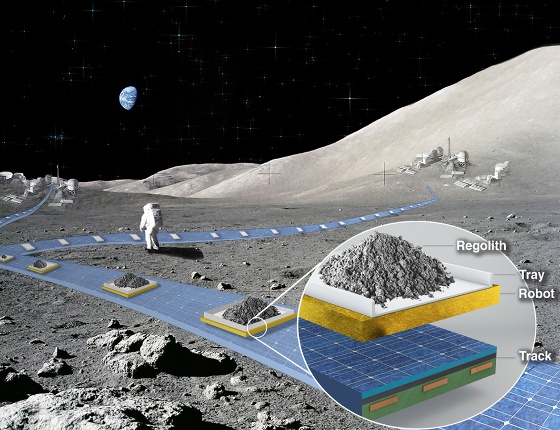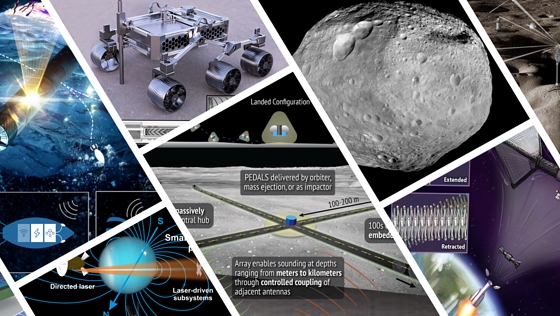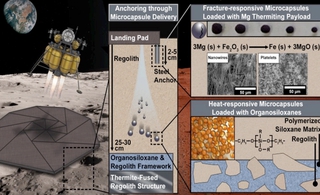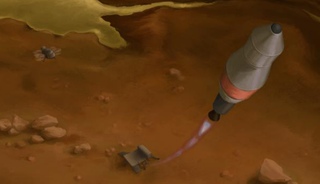 |
| March 02, 2021 | Volume 17 Issue 09 |
Designfax weekly eMagazine
Archives
Partners
Manufacturing Center
Product Spotlight
Modern Applications News
Metalworking Ideas For
Today's Job Shops
Tooling and Production
Strategies for large
metalworking plants
Far-out space concepts selected by NASA for study

Illustration of a conceptual lunar railway system selected for an early-stage feasibility study within the NASA Innovative Advanced Concepts program. [Credits: Ethan Schaler]
Early-stage research into futuristic space ideas -- a lunar levitation track system, a light-bending lunar power system, a method for making soil from asteroid material, and more -- could help revolutionize NASA's technology toolbox and pioneer new kinds of missions. More than a dozen researchers from within the agency, industry, and academia will receive grants from the NASA Innovative Advanced Concepts (NIAC) program to study their concepts' feasibility.
"NIAC Fellows are known to dream big, proposing technologies that may appear to border science fiction and are unlike research being funded by other agency programs," said Jenn Gustetic, director of early-stage innovations and partnerships within NASA's Space Technology Mission Directorate (STMD). "We don't expect them all to come to fruition but recognize that providing a small amount of seed funding for early research could benefit NASA greatly in the long run."
For 2021, STMD selected 16 Phase I NIAC proposals, which offer a range of inventions and applications. Each selected proposal will receive a grant from NASA up to $125,000. If their initial nine-month feasibility studies are successful, NIAC Fellows can apply for Phase II awards. All NIAC studies, regardless of phase, are early-stage technology development efforts. They are not considered, and may never become, NASA missions.
Among the selections is a robotics engineer at NASA's Jet Propulsion Laboratory in Southern California, offering an infrastructure idea for autonomously transporting cargo on the Moon using magnetic robots that would levitate over a flexible track. The tracks would unroll on the lunar surface, forgoing major on-site construction associated with building roads and railways on Earth. The Fellow will research another NIAC Phase I study in parallel: swimming micro-robots for exploring ocean worlds.

A researcher at NASA's Langley Research Center in Hampton, VA, will look into a concept for generating and distributing power on the Moon. The "light bender" system would capture, concentrate, and focus sunlight using telescope optics.
An industry-based researcher with Trans Astronautica Corporation proposed a conceptual method for making soil in space using carbon-rich asteroids and fungi. The concept suggests the fungi would break down the material and turn it into soil to grow food and sustain large-scale deep-space habitats.
An assistant professor at Carnegie Mellon University will investigate a lightweight and deployable structure design to allow for kilometer-scale structures in space. The proposal suggests the structure could serve as the backbone of a large rotating spacecraft capable of producing artificial gravity.
"There is an overwhelming number of new participants in the program this year," said NIAC Program Executive Jason Derleth. "All but two of the researchers selected for Phase I awards will be first-time NIAC grant recipients, showing NASA's early-stage opportunities continue to engage new creative thinkers from all over the country."
The complete list of researchers selected to receive NIAC Phase I grants in 2021 and the titles of their proposals are:
- Sarbajit Banerjee, Texas A&M Engineering Experiment Station in College Station
Regolith Adaptive Modification System to Support Early Extraterrestrial Planetary Landings - Sigrid Close, Stanford University in Stanford, CA
Exploring Uranus: Sustained ChipSat/CubeSat Activity Through Transmitted Electromagnetic Radiation (SCATTER) - Amelia Greig, University of Texas in El Paso
Ablative Arc Mining for In-Situ Resource Utilization - Zachary Manchester, Carnegie Mellon University in Pittsburgh
Kilometer-Scale Space Structures from a Single Launch - Patrick McGarey, JPL
Passively Expanding Dipole Array for Lunar Sounding (PEDALS) - Quinn Morley, Planet Enterprises in Gig Harbor, WA
Autonomous Robotic Demonstrator for Deep Drilling (ARD3) - Christopher Morrison, Ultra Safe Nuclear Corporation (USNC-Tech) in Seattle
Extrasolar Object Interceptor and Sample Return Enabled by Compact, Ultra Power Dense Radioisotope Batteries - E. Joseph Nemanick, The Aerospace Corporation in Santa Monica, CA
Atomic Planar Power for Lightweight Exploration (APPLE) - Steven Oleson, NASA's Glenn Research Center in Cleveland
Titan Sample Return Using In-situ Propellants - Marco Pavone, Stanford University
ReachBot: Small Robot for Large Mobile Manipulation Tasks in Martian Cave Environments - Ronald Polidan, Lunar Resources Inc. in Houston
FarView: In-situ Manufactured Lunar Far Side Radio Observatory - Ethan Schaler, JPL (two selections)
FLOAT: Flexible Levitation on a Track
SWIM: Sensing with Independent Micro-swimmers - Jane Shevtsov, Trans Astronautica Corporation in Lake View Terrace, CA
Making Soil for Space Habitats by Seeding Asteroids with Fungi - Charles Taylor, Langley
Light Bender: Generation and distribution of power on the lunar surface using Cassegrain telescope optics - Joshua Vander Hook, JPL
Solar System Pony Express

Graphic depiction of Regolith Adaptive Modification System (RAMs) [Credits: Sarbajit Banerjee]

Visualization of sample return launch from Titan. [Credits: Steven Oleson]
NIAC supports visionary research ideas through multiple progressive phases of study. Researchers across U.S. government, industry, and academia with high-impact ideas can submit proposals.
Phase II NIAC researchers receive up to $500,000 grants to further develop their concepts for up to two years. Phase III aims to strategically transition NIAC concepts with the highest potential impact for NASA, other government agencies, or commercial partners. Phase III researchers receive a contract up to $2 million to mature their mission concept over two years.
For more information on NASA's space technology solicitations and opportunities, visit: www.nasa.gov/directorates/spacetech/solicitations.
Source: NASA
Published March 2021
Rate this article
View our terms of use and privacy policy
